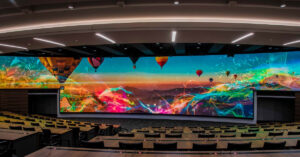
Interlaced vs Progressive Video
Published October 2, 2020

Next on our list of video building blocks is an introduction to interlaced vs progressive video format.
What is progressive video?
Progressive video has the full resolution for each frame. Every pixel is shown on every frame. This is the modern standard for digital video.
What is interlaced video?
Interlaced video has half the information for each frame while filling the same resolution. Only half the pixels actually exist. It was originally invented back in the day of analog television as a compression method, reducing the amount of bandwidth or data required without losing perceived visual quality in the broadcast.
for recording and displaying videos
How does Interlacing work?
Interlacing reduces bandwidth by using alternating lines of the video. For example, 1080i has 1080 lines of pixels. Instead of displaying all 1080 lines at once, interlacing separates the 540 even numbered lines and the 540 odd numbered lines to create two half frames. When played back at 60 fps, interlaced video looks like 30 fps as each frame is only half a frame.
What does interlacing look like?
On interlaced displays, interlaced video looks alright. In greater detailed frames, the latticed image can flicker causing issues for the viewer. You also run into issues as most playback devices today are progressive. This makes the lattices more apparent as it mixes the half frames from either side. The artifacts left behind are horizontal lines wherever there is movement. It may look like the subject is glitching from position to position.
How do you fix interlacing?
You can help reduce the negative effects of interlacing by using deinterlacing. Deinterlacing fills the empty lines with an algorithm’s best guess, based on the surrounding frames. As such, the quality of deinterlacing varies depending on the manufacturer’s exact method for deinterlacing. Deinterlacing can often be toggled on and off with in the settings of your software or hardware encoder.
While deinterlacing can help make an image look better, it is another step in processing, increasing latency and required processing power from your CPU.
See how the interlacing helps reduce the horizontal lines?
So which one is better; progressive or interlaced?
Like most tech answers, it depends. Interlacing and deinterlacing are still required today as most videos from before 2003 are interlaced. Within the professional broadcast industry, both are essential. However, within the modern live stream era of home broadcasters, progressive should be your go to. If you are truly hard pressed for bandwidth, consider dropping down to a lower progressive resolution (720p) instead of a higher interlaced resolution (1080i).
Too complicated for ya? Just want quality video for your teachers and students? Send a message or give us a call. We can help you fully integrate an easy to use lecture capture system for your classrooms.
Sources:
- https://blog.video.ibm.com/streaming-video-tips/interlaced-video-deinterlacing-for-streaming/
- https://en.wikipedia.org/wiki/Interlaced_video
- https://en.wikipedia.org/wiki/Deinterlacing
Want to get these articles a week in advance with extra deals and news? Sign up for our weekly newsletter, the Archer’s Quiver!
Get Expert AV Assistance
Latest Blogs
About Arrow AV Group
We are a premiere audiovisual integration firm serving corporate, government, healthcare, house of worship, and education markets with easy-to-use solutions that drive success. Family-owned and operated from Appleton, WI for over 35 years.




